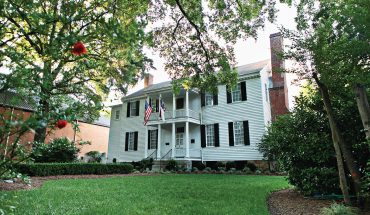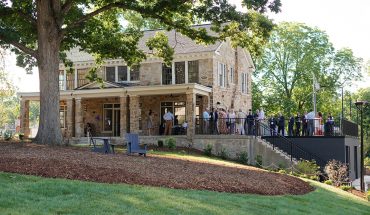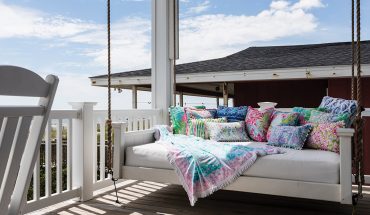
In the dining room, a Thomas Day walnut sideboard holds pieces of Jugtown pottery from the Williams’ extensive collection, Danish Modern porcelain, and a glazed turquoise bowl that picks up the color in one of Ben Williams’ modern circle paintings called Summer.
by P. Gaye Tapp
photographs by Catherine Nguyen
Clarendon Hall, built in Caswell County in 1842, was described by historian Katherine Kendall as “a rich man’s house.” Today it could be described as a house rich in art. Ben and Margaret Williams have assembled a collection here based on their love affair with art – and with a house, eternally young.
Ben Williams, now in his late 80s, was the first curator of the North Carolina Museum of Art and the curator of the Gregg Museum at N.C. State; he also studied with Henri Matisse in Paris. Margaret Williams served for years as the head of the art department at what was then St. Mary’s College in Raleigh.
Portraits of each other, and Ben’s paintings – from his early days to today – fill the walls. There is also a sizable collection of art created by some of the most esteemed artists of their day, who were and are the couple’s much-admired friends and regular visitors to the house.

“We put art everywhere,” says Ben Williams, above with wife Margaret. The walls of Clarendon Hall are full, but the couple’s collection extends to sculpture, furniture, and decorative objects. Modern and classical works fill the house by mutual consent.

The house’s second parlor – the couple’s living room – is a perfect example: Louis XV-style chairs, an Eames molded plywood chair, a Gio Ponti lamp, an inherited antique Empire sofa, and a copy of a Cumaean Sibyl with her scrolls are all at home together.
For years the couple visited Clarendon Hall on the weekends and lived in Raleigh during the week. Now the historic home is their permanent residence. Here, important modern art – including works by Morris Graves, an abstract expressionist from the Pacific Northwest, and works by British abstract painter Ben Nicholson – hang side-by-side with significant North Carolina art, including works by Francis Speight, Sarah Blakeslee, and Maud Gatewood.
It’s fitting that a couple immersed in the North Carolina art scene for more than six decades hangs its Gatewoods with its Nicholsons. Their summer sojourns to North Carolina’s Black Mountain College – an extraordinary enclave of visionary modern artists from 1933-1957 with a lasting impact on art today – are evident in the prints that line Clarendon Hall’s grand staircase. These works, by German-American expressionist Lyonel Feininger, who taught at the school, and by abstract painter Josef Albers, who led the school and taught students including Cy Twombly and Robert Rauschenberg, are a testament to the state’s long history as a wellspring of art.

A portrait over the Thomas Day mantle is of one of Virginia’s Crown Governors, c. 1740, and attributed to Charles Bridges, an English painter. The deep bronze color of a Bertoia sculpture mingles with the trompe l’oeil marble of the parlor mantel.

In the central hall, a sleek sculpture by noted North Carolina artist Horace Farlowe stands on a modern pedestal. Behind the Farlowe sculpture are works by Morris Graves and Edith London.
Art continues to fill the Williams’ days. Ben teaches, paints, and collects with Margaret. And every day they live immersed in it.
Architecturally, Clarendon Hall is beautiful, designed with Federal and Greek Revival influences. Interior details, including mantels, mouldings, doors, and the grand staircase, are attributed to Thomas Day, a free black cabinetmaker from neighboring Milton. Ben unearthed original finishes for the mantles and restored them with trompe l’oeil marble.
With such history, it would have been easy to decorate the house with antiques and period details. There is some of that, but there’s so much more in the house’s rooms, all of which are flooded with natural light. Clarendon Hall holds family antiques, modern furniture from Knoll, and handmade tables and benches by Williams. Indeed, the house has been a lifetime project for the Williamses. They’ve made extensive additions and installed a modern kitchen and bathrooms. The former stable – they call it “The Villa” – is currently being made ready for the Williams’ caretaker.

Thomas Day’s grand staircase, with feathery trompe l’oeil marble risers, sweeps up to a landing where the Williamses painted a portion of the wall black to set off another of Ben’s canvases, an abstract composed with gold leaf.

A tree that once stood near a family cabin in Roaring Gap, N.C. provided Ben with the wood for several long, low tables or benches that are used as coffee tables in the den and parlor.

An Isamu Noguchi table in the central hall displays a sculpture Ben made from the same tree that provided the wood for the benches.
It would be impossible to appreciate the house separately from the Williamses. There is a vibrational pull between their art and the house that can only be attributed to the love, enthusiasm, and knowledge the couple has for art and the creative process. The couple reflects a similar harmony: Margaret’s calm demeanor and Ben’s exuberance embody the same rhythm as the house and its art, all in perfect consonance.
“Art cannot be separated from life,” said Robert Henri, the American realist painter, teacher, and founding member of the Ashcan School. “It is the expression of the greatest need of which life is capable, and we value art not because of the skilled product, but because of its revelation of a life’s experience.” As great admirers of Henri, and as artists and teachers, both Ben and Margaret Williams have lived their lives according to this philosophy. Surrounding themselves with art has been the experience of their lifetime.

In the dining room, a hand-crafted cabinet featuring panels inset with pine straw weaving by Angelika Rackendorf sits in front of a Thomas Day mantel.

Ben Williams paints in the upstairs hall. Just beyond is a bedroom co-opted for the overflow of paintings that will get hung on the walls, when the mood strikes. Over the mantle is a painting Ben created while working as a copyist for the National Gallery in Washington, D.C.











